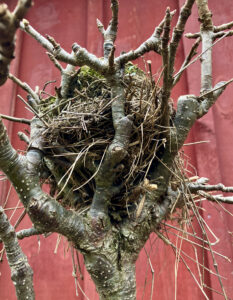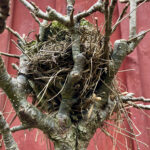 All summer long a pair of blue jays flitted around one of our espaliered pear trees, hopping from the barn gutter to the ground to the top limb of the tree where they’d disappear into its leafy shadows. Despite all the feints and evasive maneuvers, it was clear that the jays were nesting. But it wasn’t until the last of the leaves had fallen a few weeks ago that I discovered where. Packed into the spikey circle of twigs at the tree’s crown, woven with moss and straw and pine needles, was a miracle of avian engineering that had blended perfectly into its surroundings.
All summer long a pair of blue jays flitted around one of our espaliered pear trees, hopping from the barn gutter to the ground to the top limb of the tree where they’d disappear into its leafy shadows. Despite all the feints and evasive maneuvers, it was clear that the jays were nesting. But it wasn’t until the last of the leaves had fallen a few weeks ago that I discovered where. Packed into the spikey circle of twigs at the tree’s crown, woven with moss and straw and pine needles, was a miracle of avian engineering that had blended perfectly into its surroundings.
The fall reveals so many things that had been hidden in plain sight by summer’s canopies of green: the cresting wave of the mountain ridge, lichen-covered stone walls wandering into the woods, a head-sized wasp’s nest swinging from the upper branches of the oak tree. Jane Hirshfield’s poems are revelatory in the same way. They’re acts of precise observation — of both the known world and the elusive realms hidden within.
Meeting the Light Completely
by Jane Hirshfield
Even the long-beloved
was once
an unrecognized stranger.
Just so,
the chipped lip
of a blue-glazed cup,
blown field
of a yellow curtain,
might also,
flooding and falling,
ruin your heart.
A table painted with roses.
An empty clothesline.
Each time,
the found world surprises—
that is its nature.
And then
what is said by all lovers:
“What fools we were, not to have seen.”



Hello again…
I was so glad you shared this poem. I love it and it had been ages since I last read it. I have saved it.
I am often amazed at how the birds fashion their nests. The one shown here certainly is a feat of engineering.
Thank you, Cheryl. I always look forward to hearing from you about poetry and nature and life.
Liza, this is a lovely post and a lovely poem. Thanks so much for sharing your observations and your knowledge of poetry!
Thanks, Phyllis! Here’s to more poetry in the year ahead.